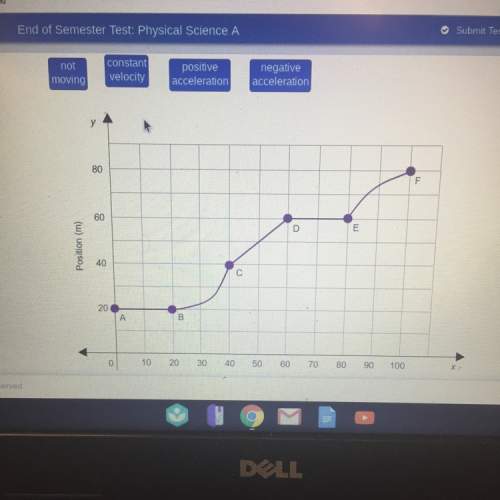
Physics, 21.08.2019 14:00 kataldaine
Ahelicopter’s speed increases from 25 m/sec to 60 m/sec in 5 seconds. what is the acceleration of this
helicopter?

Answers: 1


Other questions on the subject: Physics

Physics, 21.06.2019 23:00, alanisalvarez2000
Follow these directions and answer the questions. 1. set up the ripple tank as in previous investigations. 2. bend the rubber tube to form a "concave mirror" and place in the ripple tank. the water level must be below the top of the hose. 3. generate a few straight pulses with the dowel and observe the reflected waves. do the waves focus (come together) upon reflection? can you locate the place where the waves meet? 4. touch the water surface where the waves converged. what happens to the reflected wave? 5. move your finger twice that distance from the hose (2f = c of c, center of the curvature) and touch the water again. does the image (the reflected wave) appear in the same location (c of c)? you may have to experiment before you find the exact location. sometimes it is hard to visualize with the ripple tank because the waves move so quickly. likewise, it is impossible to "see" light waves because they have such small wavelengths and move at the speed of light. however, both are examples of transverse waves and behave in the same way when a parallel wave fronts hit a curved surface.
Answers: 1

Physics, 22.06.2019 05:50, Dweath50
Give your knowledge of these things in your paper, you will compare and contrast analog and digital signals to determine which is more reliable for encoding and transmitting information. you’ll compare these features: signal shape numerical values for signal measurements amount of data that can be transmitted energy requirements privacy and security (ability of the signal to be encoded in a secret code) clarity of signal in the space provided, write down what you already know about any of these features. if you’re not sure, write down questions you might have about the features.
Answers: 3


Physics, 23.06.2019 01:00, exoticbunnylover123
Learning goal: to understand newton's 1st law. newton's principia states this first law of motion: an object subject to no net force maintains its state of motion, either at rest or at constant speed in a right line. this law may be restated as follows: if the sum of all forces acting on an object is zero, then the acceleration of that object is zero. mathematically this is just a special case of the 2nd law of motion, f⃗ =ma⃗ , when f⃗ =0. when studying newtonian mechanics, it is best to remember the 1st law in two ways: if the net force (i. e., sum of all forces) acting on an object is zero, the object will keep moving with constant velocity (which may be zero). if an object is moving with constant velocity, that is, with zero acceleration, then the net force acting on that object must be zero. complete the following sentences to see if you can apply these ideas. part a if a car is moving to the left with constant velocity, one can conclude that
Answers: 1
You know the right answer?
Ahelicopter’s speed increases from 25 m/sec to 60 m/sec in 5 seconds. what is the acceleration of th...
Questions in other subjects:


English, 11.07.2019 07:10







English, 11.07.2019 07:10





